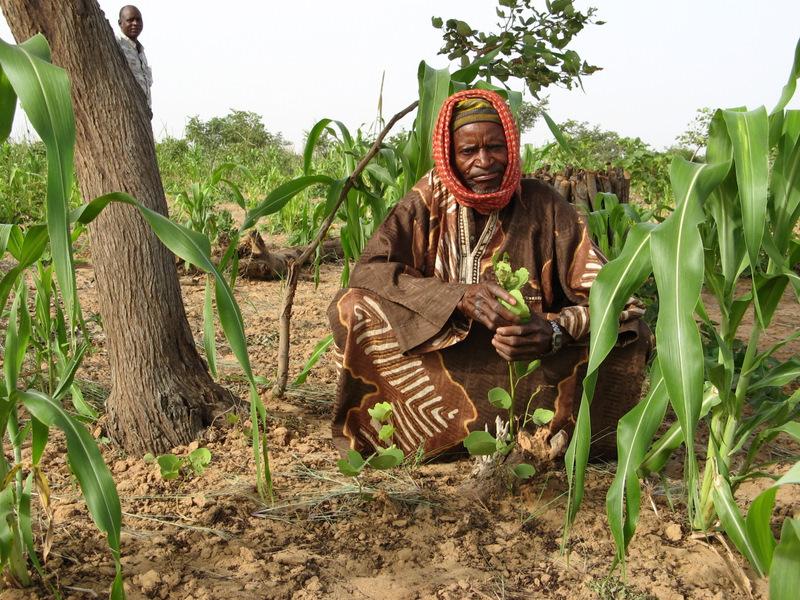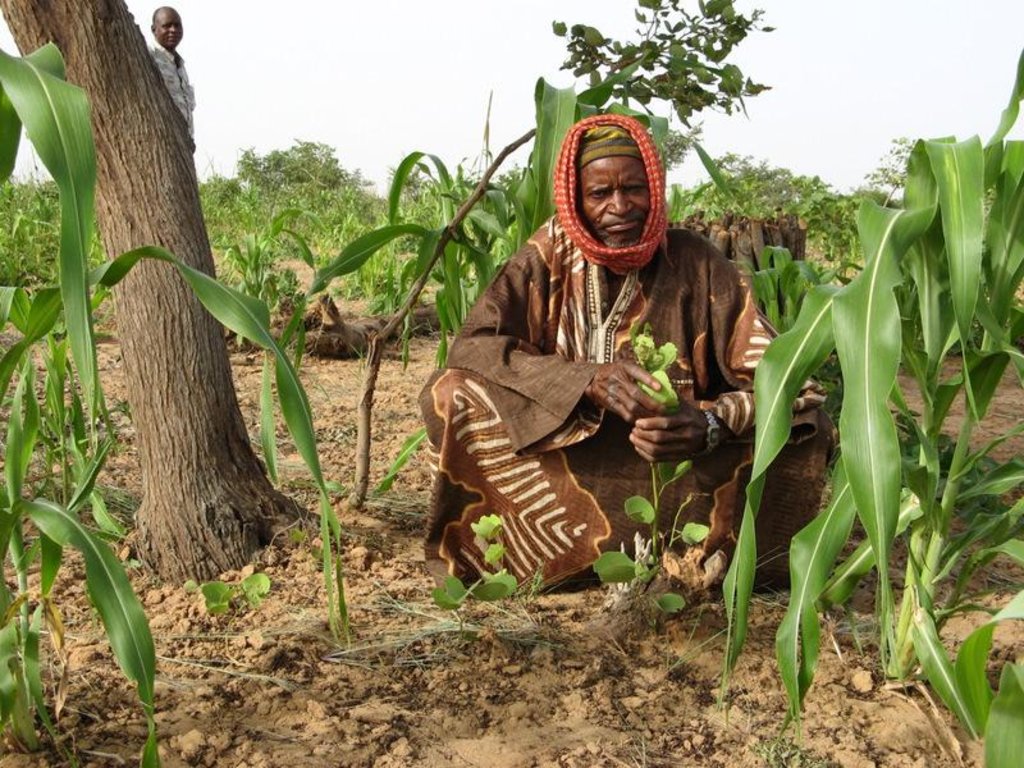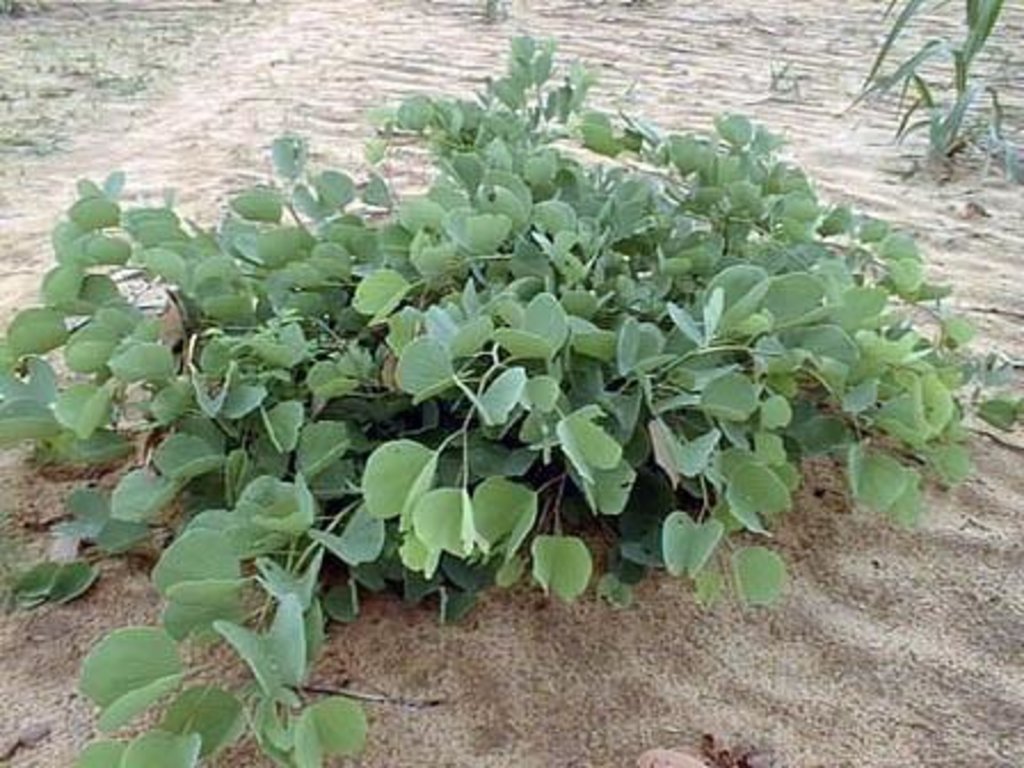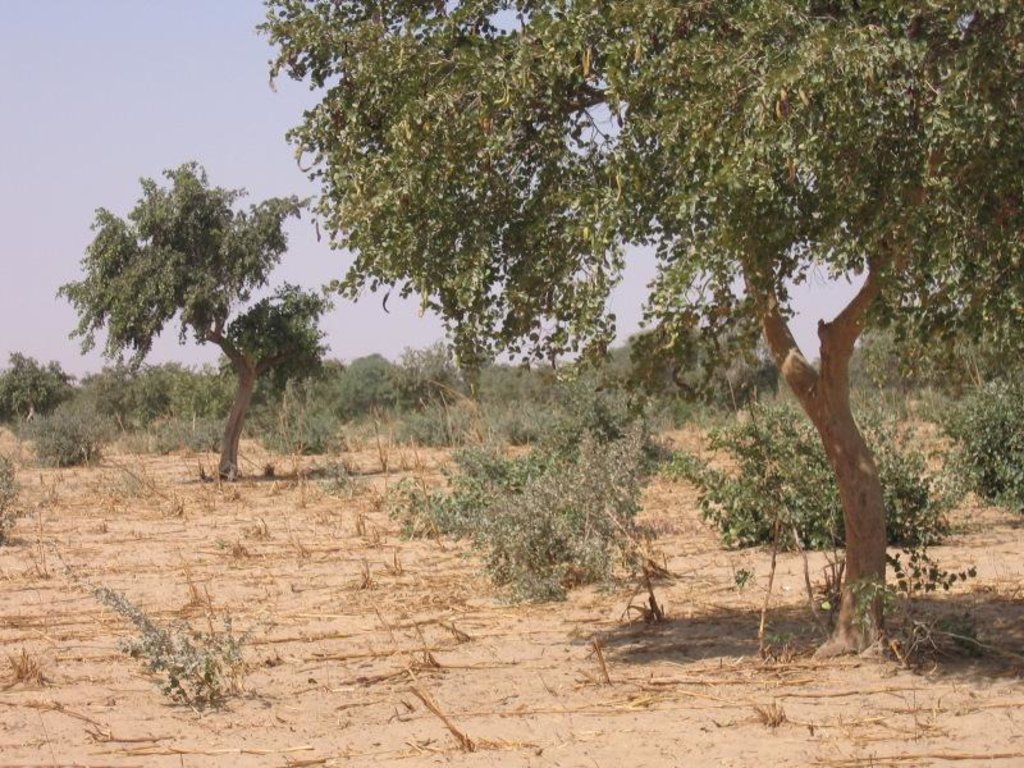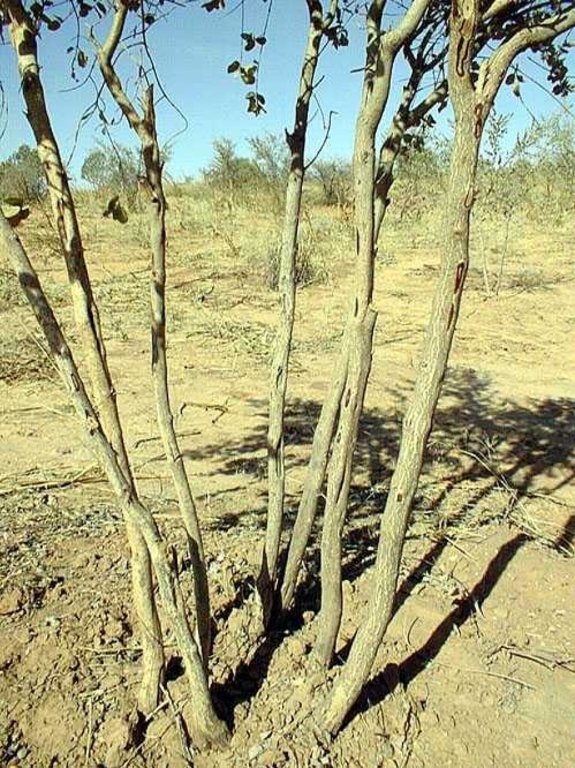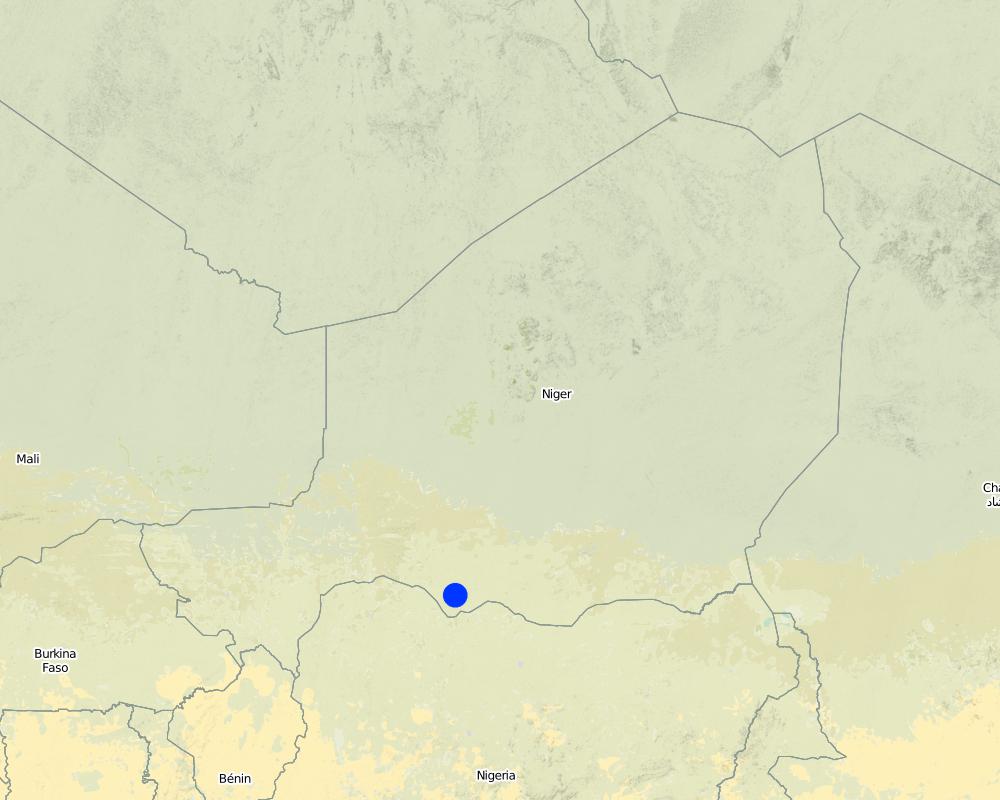Farmer Managed Natural Regeneration [尼日尔 ]
- 创建:
- 更新:
- 编制者: Unknown User
- 编辑者: –
- 审查者: David Streiff, Deborah Niggli, Alexandra Gavilano
technologies_1340 - 尼日尔
查看章节
全部展开 全部收起1. 一般信息
1.2 参与该技术评估和文件编制的资源人员和机构的联系方式
关键资源人
SLM专业人员:
Rinaudo Tony
World Vision
澳大利亚
SLM专业人员:
Pasternak Dov
ICRISAT
荷兰
有助于对技术进行记录/评估的项目名称(如相关)
Book project: SLM in Practice - Guidelines and Best Practices for Sub-Saharan Africa (SLM in Practice)有助于对技术进行记录/评估的机构名称(如相关)
ICRISAT (ICRISAT) - 尼日尔有助于对技术进行记录/评估的机构名称(如相关)
World Vision (World Vision) - 瑞士1.3 关于使用通过WOCAT记录的数据的条件
编制者和关键资源人员接受有关使用通过WOCAT记录数据的条件。:
是
1.5 参考关于SLM方法(使用WOCAT记录的SLM方法)的调查问卷
2. SLM技术的说明
2.1 技术简介
技术定义:
FMNR is the systematic regeneration of living and sprouting stumps of indigenous vegetation which used to be slashed and burned in traditional field preparation.
2.2 技术的详细说明
说明:
The naturally occurring seedlings and/or sprouts are managed and protected by local farmers. Most suitable are species with deep roots that do not compete with crops and have good growth performance even during poor rainy seasons. In the case study area the three most valuable species – as perceived by land users – are Faidherbia albida; Piliostigma reticulatum and Guiera senegalensis.
Purpose of the Technology: This option allows idle land to become a productive resource during an otherwise unproductive eight-month dry season.
Establishment / maintenance activities and inputs: The ideal density, when grown with cereal crops, is between 50 and 100 trees per hectare. For each stump, the tallest and straightest stems are selected and side branches removed to roughly half of the stem height. Excess shoots are then removed. Regular pruning of any unwanted new stems and side branches stimulates growth rates. Farmers are encouraged to leave 5 stems / shoots per tree, cutting one stem each year and letting another grow in its place. On removing a shoot, the cut leaves are left on the surface where they reduce erosion and are then eaten by termites, returning the nutrients to the soil. The remaining shoots continue to grow, providing a continuous supply of wood. From the first year, firewood is collected from trimmings. From the second year on, cut branches are thick enough to sell. A more intensive form of FMNR is to profit from every stump sprouting on the land.
Natural / human environment: FMNR is a simple, low-cost and multi-benefit method of re-vegetation, accessible to all farmers, and adapted to the needs of smallholders. It reduces dependency on external inputs, is easy to practice and provides multiple benefits to people, livestock, crops and the environment. Tree layout will need to be carefully considered if ploughs are used for cultivation.
2.3 技术照片
2.5 已应用该技术的、本评估所涵盖的国家/地区/地点
国家:
尼日尔
有关地点的进一步说明:
Maradi
具体说明该技术的分布:
- 均匀地分布在一个区域
如果技术均匀分布在一个区域,则指定覆盖的区域(单位为平方千米):
50000.0
如果不知道精确的区域,请注明大致覆盖的区域:
- > 10,000 平方千米
注释:
Total area covered by the SLM Technology is 50000 km2.
Map
×2.6 实施日期
如果不知道确切的年份,请说明大概的日期:
- 10-50年前
2.7 技术介绍
详细说明该技术是如何引入的:
- 通过土地使用者的创新
注释(项目类型等):
early 1980's
3. SLM技术的分类
3.1 该技术的主要目的
- 改良生产
3.2 应用该技术的当前土地利用类型

农田
- 一年一作
注释:
Major land use problems (land users’ perception): Deforestation, Wind erosion, Water deficiency, Movement of sand dunes
Future (final) land use (after implementation of SLM Technology): Mixed: Mf: Agroforestry
3.3 由于技术的实施,土地使用是否发生了变化?
由于技术的实施,土地使用是否发生了变化?:
- 是(请在技术实施前填写以下有关土地利用的问题)

农田
- 一年一作
3.4 供水
该技术所应用土地的供水:
- 雨养
3.5 该技术所属的SLM组
- 天然和半天然森林管理
3.6 包含该技术的可持续土地管理措施

植物措施
- V1:乔木和灌木覆盖层

管理措施
- M1:改变土地使用类型
注释:
Type of vegetative measures: scattered / dispersed
3.7 该技术强调的主要土地退化类型

土壤风蚀
- Et:表土流失
- Ed:风蚀风积

生物性退化
- Bc:植被覆盖的减少
- Bq:数量/生物量减少
- Bs:质量和物种组成/多样性的下降

水质恶化
- Ha:干旱化
注释:
Secondary types of degradation addressed: Bs: quality and species composition /diversity decline, Ha: aridification
3.8 防止、减少或恢复土地退化
具体数量名该技术与土地退化有关的目标:
- 减少土地退化
- 修复/恢复严重退化的土地
注释:
Secondary goals: mitigation / reduction of land degradation
4. 技术规范、实施活动、投入和成本
4.1 该技术的技术图纸
技术规范(与技术图纸相关):
Technical knowledge required for field staff / advisors: moderate
Technical knowledge required for land users: moderate
Main technical functions: increase in organic matter, increase in nutrient availability (supply, recycling,…), reduction in wind speed, increase of biomass (quantity), promotion of vegetation species and varieties (quality, eg palatable fodder)
Secondary technical functions: control of raindrop splash, increase of infiltration
Scattered / dispersed
Vegetative material: T : trees / shrubs
Number of plants per (ha): 50
Trees/ shrubs species: Faidherbia albida, Piliostigma reticulatum, Guiera senegalensis
4.2 有关投入和成本计算的一般信息
具体说明成本计算所用货币:
- 美元
4.3 技术建立活动
| 活动 | 时间(季度) | |
|---|---|---|
| 1. | Select 50 - 100 stumps per hectare for regrowth during the dry season | dry season |
| 2. | Select the tallest and straightest stems and prune side branches to roughly half the height of the stem (using sharpened axe or machete and cutting upwards carefully) | |
| 3. | Remove excess shoots, leave the cut leaves on the surface | |
| 4. | Prune any unwanted new stems and side branches (each 2-6 months) |
4.4 技术建立所需要的费用和投入
| 对投入进行具体说明 | 单位 | 数量 | 单位成本 | 每项投入的总成本 | 土地使用者承担的成本% | |
|---|---|---|---|---|---|---|
| 劳动力 | Labour | ha | 1.0 | 6.0 | 6.0 | 100.0 |
| 技术建立所需总成本 | 6.0 | |||||
| 技术建立总成本,美元 | 6.0 | |||||
4.5 维护/经常性活动
| 活动 | 时间/频率 | |
|---|---|---|
| 1. | Cut one stem (per tree) each year and let another grow in its place | |
| 2. | Once the stems selected for growth are > 2 meters high, they can be pruned up to two thirds | |
| 3. | Prune any unwanted new stems and side branches (each 2-6 months) |
4.6 维护/经常性活动所需要的费用和投入(每年)
| 对投入进行具体说明 | 单位 | 数量 | 单位成本 | 每项投入的总成本 | 土地使用者承担的成本% | |
|---|---|---|---|---|---|---|
| 劳动力 | Labour | ha | 1.0 | 4.0 | 4.0 | 100.0 |
| 技术维护所需总成本 | 4.0 | |||||
| 技术维护总成本,美元 | 4.0 | |||||
注释:
Machinery/ tools: All activities carried out manually
Annual income from selling wood: US$ 140 (from the 6th year after implementation). By some estimates, total benefit per hectare (incl. wood sales, increased crop yield, increased livestock productivity, wild foods and medicines etc) are in the order of US$ 200/ha, compared to an investment in labour US$ 10-15.
4.7 影响成本的最重要因素
描述影响成本的最决定性因素:
Main costs are in the form of labour. One man could prepare one hectare in 1–3 days, depending on tree density (labour is undertaken by the farm owner and rarely through paid labour). No inputs used; no extra tools needed, tools are available on-farm (hoe, axe, machete etc). Maintenance costs depend on tree density also and could require 1–2 days/year/ha.
5. 自然和人文环境
5.1 气候
年降雨量
- < 250毫米
- 251-500毫米
- 501-750毫米
- 751-1,000毫米
- 1,001-1,500毫米
- 1,501-2,000毫米
- 2,001-3,000毫米
- 3,001-4,000毫米
- > 4,000毫米
农业气候带
- 半干旱
Thermal climate class: tropics
5.2 地形
平均坡度:
- 水平(0-2%)
- 缓降(3-5%)
- 平缓(6-10%)
- 滚坡(11-15%)
- 崎岖(16-30%)
- 陡峭(31-60%)
- 非常陡峭(>60%)
地形:
- 高原/平原
- 山脊
- 山坡
- 山地斜坡
- 麓坡
- 谷底
垂直分布带:
- 0-100 m a.s.l.
- 101-500 m a.s.l.
- 501-1,000 m a.s.l.
- 1,001-1,500 m a.s.l.
- 1,501-2,000 m a.s.l.
- 2,001-2,500 m a.s.l.
- 2,501-3,000 m a.s.l.
- 3,001-4,000 m a.s.l.
- > 4,000 m a.s.l.
关于地形的注释和进一步规范:
Altitudinal zone: 200-300 m a.s.l.
5.3 土壤
平均土层深度:
- 非常浅(0-20厘米)
- 浅(21-50厘米)
- 中等深度(51-80厘米)
- 深(81-120厘米)
- 非常深(> 120厘米)
表土有机质:
- 低(<1%)
如有可能,附上完整的土壤描述或具体说明可用的信息,例如土壤类型、土壤酸碱度、阳离子交换能力、氮、盐度等。:
Soil fertility is low
Soil drainage / infiltration is poor
5.6 应用该技术的土地使用者的特征
生产系统的市场定位:
- 混合(生计/商业)
相对财富水平:
- 非常贫瘠
- 贫瘠
个人或集体:
- 个人/家庭
机械化水平:
- 手工作业
说明土地使用者的其他有关特征:
Land users applying the Technology are mainly disadvantaged land users
Population density: 10-50 persons/km2
5.7 应用该技术的土地使用者使用的平均土地面积
- < 0.5 公顷
- 0.5-1 公顷
- 1-2 公顷
- 2-5公顷
- 5-15公顷
- 15-50公顷
- 50-100公顷
- 100-500公顷
- 500-1,000公顷
- 1,000-10,000公顷
- > 10,000公顷
这被认为是小规模、中规模还是大规模的(参照当地实际情况)?:
- 小规模的
5.8 土地所有权、土地使用权和水使用权
土地所有权:
- 个人,未命名
土地使用权:
- 个人
6. 影响和结论性说明
6.1 该技术的现场影响
社会经济效应
生产
作物生产
注释/具体说明:
At least doubled
畜牧生产
注释/具体说明:
Nutritious pods as fodder
木材生产
注释/具体说明:
Production value increased by 57%
收入和成本
农业收入
工作量
注释/具体说明:
Annual clearing and burning of tree stems (for land preparation) is not necessary any more
社会文化影响
食品安全/自给自足
注释/具体说明:
Edible leaves/fruits; bridge food shortages
quality of life
注释/具体说明:
Reduced wind speeds and dust; shade is available; barren landscape is returning to a natural savannah
disaster risk reduction
注释/具体说明:
FMNR acts as an insurance policy
livelihood and human well-being
生态影响
土壤
土壤覆盖层
SLM之前的数量:
30
SLM之后的数量:
45
注释/具体说明:
trees / ha
Increased tree density on farmland
养分循环/补给
注释/具体说明:
Dung; livestock spends more time in fields with trees
土壤有机物/地下C
注释/具体说明:
From leaf fall and trimmings
生物多样性:植被、动物
生物量/地上C
植物多样性
有益物种
栖息地多样性
注释/具体说明:
Creation of habitat, food and shelter for predators of crop pests
害虫/疾病控制
减少气候和灾害风险
干旱影响
注释/具体说明:
Regenerated trees are indigenous and generally have mature root systems
风速
注释/具体说明:
Resulting in greater deposition of rich, wind blown silt; improved micro-climate
6.2 该技术的场外影响已经显现
Urban populations benefit from cheaper, sustained wood supply and reduced incidence of dust storms
6.3 技术对渐变气候以及与气候相关的极端情况/灾害的暴露和敏感性(土地使用者认为的极端情况/灾害)
渐变气候
渐变气候
| 季节 | 增加或减少 | 该技术是如何应对的? | |
|---|---|---|---|
| 年温度 | 增加 | 好 |
气候有关的极端情况(灾害)
气象灾害
| 该技术是如何应对的? | |
|---|---|
| 局地暴雨 | 好 |
| 局地风暴 | 好 |
气候灾害
| 该技术是如何应对的? | |
|---|---|
| 干旱 | 好 |
6.4 成本效益分析
技术收益与技术建立成本相比如何(从土地使用者的角度看)?
短期回报:
积极
长期回报:
非常积极
技术收益与技术维护成本/经常性成本相比如何(从土地使用者的角度看)?
短期回报:
积极
长期回报:
非常积极
注释:
Annual income from selling wood: US$ 140 (from the 6th year after implementation).
6.5 技术采用
- > 50%
在所有采用这项技术的人当中,有多少人是自发的,即未获得任何物质奖励/付款?:
- 91-100%
注释:
Comments on spontaneous adoption: Spread has been largely spontaneous, with minimal external assistance. The area covered today by trees from FMNR is estimated to be more than 50,000 km2 in Niger.
6.7 该技术的优点/长处/机会
| 编制者或其他关键资源人员认为的长处/优势/机会 |
|---|
| FMNR is a simple, low-cost and multi-benefit method of re-vegetation, accessible to all farmers, and adapted to the needs of smallholders |
| It reduces dependency on external inputs, is easy to practice and provides multiple benefits to people, livestock, crops and the environment |
6.8 技术的弱点/缺点/风险及其克服方法
| 编制者或其他关键资源人员认为的弱点/缺点/风险 | 如何克服它们? |
|---|---|
| Scarce presence of live tree stumps | alternatively broadcast seeds of indigenous species (reduced short-term benefits; high mortality rates) |
| Cultural norms and values: ‘a good farmer is a clean farmer’ (= no trees) | work with all stakeholders to change norms |
| Land (including trees) is treated as common property during dry season; damaging and removing trees on other people’s land occurs | create sense of ownership of trees: (1) Encourage communities to develop rules that respect property; (2) Local forestry authorities granting informal approval for farmers to be able to reap the benefits of their work. |
7. 参考和链接
7.2 参考可用出版物
标题、作者、年份、ISBN:
Rinaudo T (1999): Utilizing the Underground Forest: Farmer Managed Natural Regeneration of Trees, in Dov Pasternak and Arnold Schlissel (Eds). Combating Desrtification with Plants.
标题、作者、年份、ISBN:
Cunningham PJ and Abasse T (2005): Reforesting the Sahel: Farmer Managed Natural Regeneration; in Kalinganire A, Niang A and Kone A (2005). Domestication des especes agroforestieres au Sahel: situation actuelle et perspectives. ICRAF Working Paper, ICRAF, Nairobi.
标题、作者、年份、ISBN:
Haglund E, Ndjeunga J, Snook L, and Pasternak D (2009): Assessing the Impacts of Farmer Managed Natural Regeneration in the Sahel: A Case Study of Maradi Region, Niger (Draft Version)
链接和模块
全部展开 全部收起链接
无链接
模块
无模块


